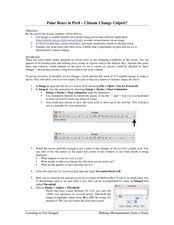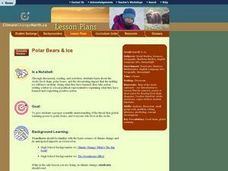Curated OER
Why Polar Bears Are White
Students are introduced to the concept of camouflage and protective coloration as well as Arctic animals. They examine how color can help animals in the wild. Students discuss where polar bears live and why they are white.
Curated OER
Polar Bears in Peril - Climate Change Culprit?
Students explore the changes in sea ice over several years. In this life science lesson, students review and examine 20 years of data. They use Excel to graph data and analyze trends.
Curated OER
Polar Bear Needs a Home!
Third graders are introduced to the topic of habitat . They create a zoo exhibit fo a polar bear that is being donated to the Albuquerque Zoo. The zoo is not big enough for a brand new cage, so the students choose which of three...
Curated OER
Keeping Warm When it is Cold: How does a polar bear keep warm?
Students make a model of a polar bear and discuss why fur/skin color is important. They also perform a simple experiment using black and white socks to determine how color affects temperature.
Curated OER
Bears
The Grizzly, Polar, and Panda are all types of bears; they are also the topic of this informative presentation. Each slide contains numerous facts about bear habitats, food resources, and characteristics. Fun photographs, sound, and...
Curated OER
Goldilocks and the Real Bears
Students participate in a comparison lesson where they compare fictional bears to real life bears. In this science/language arts lesson, students read Goldilocks and the Three Bears. Students observe characteristics...
Curated OER
Polar Pals: Polar Bears & Penguins
First graders complete a variety of activities about polar bears and penguins including the "Blubber Mitten" experiment. They culminate the unit by creating a visual representation comparing and contrasting the two animals.
Curated OER
Polar Bears Past Bedtime
For this crossword puzzle worksheet about polar bears, students are given 8 descriptions from which to find words which fit in the crossword format.
Curated OER
Polar Bears and Ice
Students explore the Arctic food chain. They examine the needs of the polar bear and the threat that global warming poses to them. Students write a letter to a local political representative explaining what they have studied and...
Curated OER
Which Bear?
Students study bears. In this science instructional activity, students compare black, grizzly and polar bears. Students measure the bear tracks and compare the bear habitats and diet.
Curated OER
Lars the Little Polar Bear
In this Little Polar Bear worksheet, students view a video of the story, and then sequence sentences that match the story. Students sequence 6 sentences.
Curated OER
Global Warming
First graders discover the effects of global warming on polar bears. In this life science lesson, 1st graders model the polar bear's habitat and observe what happens as they raise the temperature. They record their observation in the...
Curated OER
Fitting In-Animals' Adaptations to Their Environment
In this animals' adaptation to their environment worksheet, students read for comprehension and ability to apply knowledge. In this T-Chart and creative activities worksheet, students answer three questions.
Curated OER
Take Your Pick of "Beary" Fun Activities.
Students complete an integrated unit on bears. They read numerous books about bears, create a bear puppet, act-out stories, create a polar bear painting, participate in a Teddy Bear Picnic, and conduct a Teddy Bear parade.
Curated OER
Polar Bear Panic!
Students identify the three realms of the Arctic Ocean, and describe the relationships between these realms. They graphically analyze data on sea ice cover in the Arctic Ocean, and recognize a trend in these data.
Curated OER
Blubber Mittens:Adaptation to Cold Climates
Learners get a first hand look at the benefit of a "blubber layer" in cold climates through a simulation using vegetable shortening and icy water. Through this simulation, students examine how adaptations help organisms survive.
Macmillan Education
Happy 40th Birthday Brown Bear
What do you see? Wish a happy birthday to Bill Martin Jr. and Eric Carle's Brown Bear, Brown Bear, What Do You See? The lesson includes six extension activities for the books and its companion stories, including a maze and...
Curated OER
Sense of Hearing
Students explore the sense of hearing. In this human biology lesson, students listen to the story Polar Bear, Polar Bear, What Do You Hear? and give examples of how they use their sense of hearing everyday. Students pass around plastic...
Curated OER
Endangered Species: Report Planner
For this science related worksheet, students write three things they would like to learn about an endangered species and then list the resources they plan on using to secure the answers to their three facts.
Curated OER
Life in the Freezer
For this global warming worksheet, climatologists examine a few possible results of climate change. There is no specific reading from which learners extrapolate the information needed to answer the questions, so you will need to preface...
NOAA
Climate Is Our Friend…Isn’t It?: Make an Extinction Polyhedron
Climate affects populations in different ways. Scholars research extinct organisms and mass extinctions in part three of the 10-installment Discover Your Changing World series. They create graphic organizers, then fill in the...
Super Teacher Worksheets
Mammal Scavenger Hunt Activity
Did you know that a polar bear's skin is actually black? Or that the lightest mammal weighs less than a paperclip? Young scientists learn these and other amazing facts about mammals as they explore the animal kingdom with...
Curated OER
Brown Bear Pudding Style!
Students are read the story "Brown Bear, Brown Bear". They create their own bear painting out of chocolate pudding. They are allowed to bring in their own stuffed animal to make the first day better for them.

























